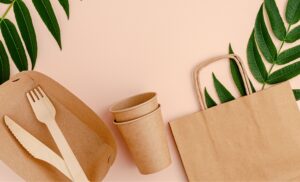In an era where environmental consciousness is at an all-time high, the demand for eco-friendly tableware and food packaging is on the rise. Consumers and businesses alike are seeking sustainable alternatives to traditional single-use plastics. Let’s explore the latest trends shaping the world of eco-friendly dining and packaging.
Biodegradable Materials Are Gaining Ground:
One of the most prominent trends is the increased use of biodegradable materials in tableware and packaging. Materials like sugarcane bagasse, cornstarch, and bamboo are becoming popular choices. These materials break down naturally, reducing the environmental footprint of disposable items.
Compostable Packaging Solutions:
Compostable food packaging has gained momentum. Items like compostable plates, cutlery, and packaging can be composted along with organic waste, diverting them from landfills and contributing to nutrient-rich soil.
The Rise of Reusable Tableware:
Reusable tableware, such as stainless steel, bamboo, and glass, is becoming more mainstream. Consumers are opting for durable, long-lasting options to reduce waste and promote sustainability.
Innovative Plant-Based Plastics:
Plant-based plastics, like PLA (polylactic acid), are being used as an alternative to traditional plastics. They are derived from renewable resources and can be composted under specific conditions.
Sustainable Packaging Design:
Packaging and tableware design is evolving to focus on sustainability and minimalism. Designers are striving to create products that are functional, using fewer materials and reducing waste.
Ethical Sourcing and Supply Chains:
Ethical sourcing of materials used in eco-friendly tableware is gaining attention. Consumers are increasingly concerned about the environmental and social impact of their choices, pushing companies to adopt responsible sourcing practices.
Local and Sustainable Sourcing:
Businesses are placing greater emphasis on locally sourcing materials to reduce transportation emissions and support local economies. Sustainable sourcing practices, such as responsible forestry, are also on the rise.
Reduction in Packaging:
Companies are actively working to reduce the amount of packaging they use. Innovations such as edible packaging and packaging-free stores are emerging as part of this trend.
Heightened Consumer Awareness:
Consumer awareness about the environmental impact of tableware and packaging is at an all-time high. This awareness is driving demand for eco-friendly options and pushing businesses to be more environmentally responsible.
Government Regulations:
Governments in various regions are enacting regulations to curb the use of single-use plastics and promote eco-friendly alternatives. These regulations are shaping the industry landscape.
In conclusion, the trends in eco-friendly tableware and food packaging reflect a broader shift toward sustainable and responsible consumption. Whether it’s the use of biodegradable materials, the promotion of compostable packaging, or a focus on ethical sourcing, these trends are making a positive impact on the environment. As consumers continue to prioritize eco-friendliness, the industry is sure to see even more innovations in the years to come.






